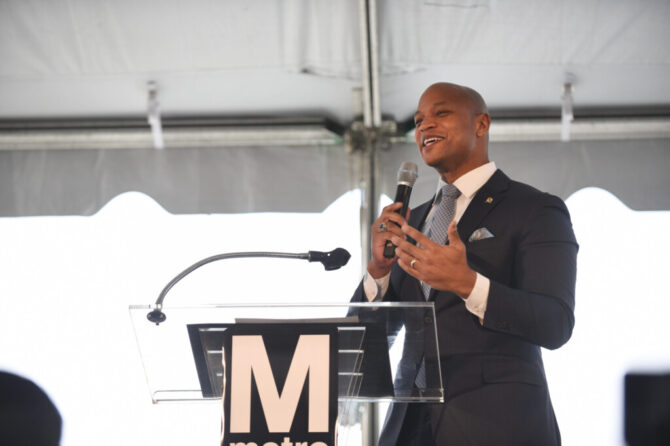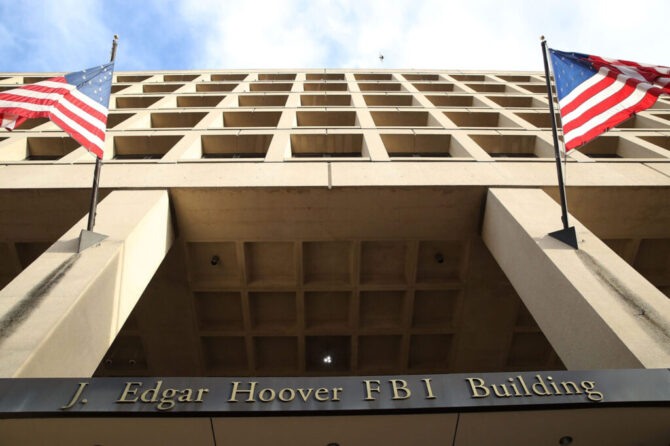BALTIMORE BANNER: The small city in Prince George’s County has a rich history dating back to FDR’s New Deal, but it’s certain to change once the FBI relocates to a new headquarters there.
The walls of the tiny office shared by Bryan Butler and Frank Jones are filled with success stories.
Every kid who comes through the Springhill Lake Recreation Center — every child whose lives were touched by homework help, basketball and the guidance of strong Black men — gets to put a photo on those walls.
There are thousands of them.
Black and brown faces smile at Butler and Jones, Coach Kevin Lockhart and Louis Brown, a young assistant helping elementary school kids with homework in an aftercare program. They are in caps and gowns and football uniforms.
The one condition is that the kids have to graduate high school to get on the wall.
This is the part of Greenbelt where that isn’t always a sure thing — Franklin Park. It doesn’t have a place in the town museum, it wasn’t highlighted in the announcement that the FBI will move its headquarters, 7,000 employees and untold economic opportunities to Greenbelt.
“This is the bad part, right here,” said Brown, who grew up in the 3,000-unit apartment complex.
The “good part” of Greenbelt, about 25 to 30 miles from Baltimore and Annapolis, is a historic place.
Old Town, about 1,800 homes spreading out from the crescent-shaped main road, was built as an experiment in public housing policy. Started during the Great Depression, it is a relic of a 1930s debate over the federal government helping the “deserving poor” with jobs and decent homes when both were scarce.
Critics called it a socialist menace, a plot by President Franklin Delano Roosevelt’s New Deal that would replace capitalism with communism. Its prime mover was Undersecretary of Agriculture Rexford Guy Tugwell, dubbed “Red Rex” by his enemies.
The idea was almost abandoned before it was finished in the early 1940s when Tugwell quit, fed up with the limited vision of his critics. First lady Eleanor Roosevelt convinced her husband to let her step in and see the project through.
The first 880 homes were built, then came another 1,000. The philosophy behind Greenbelt didn’t survive the postwar housing boom in the Maryland suburbs of Washington, D.C., and by 1952 the federal government sold it to a co-op made up of individual homeowners.
“World War II got in the way, to be honest,” said Megan Searing Young, director of the Greenbelt Museum.
That history is all over Greenbelt today, from Lenore Thomas Straus’ social realism style bas-relief depictions of the preamble to the Constitution to the co-op grocery and New Deal Cafe, to Eleanor Roosevelt High School and the Franklin Place apartments, where Brown grew up.
All of this will change when the FBI arrives.
The move announced last week after a decade-long selection process that must still win funding from Congress, where Virginians and Marylanders are quarreling over the General Service Administration’s decision. Construction of a new headquarters on land owned by Washington’s transit authority, Metro, near Greenbelt Station, might take another decade.
Over time, 7,000 FBI employees will choose homes nearer to work, shop close by and eat in restaurants within easy reach. Their children will attend local schools and all of them will drive on local roads.
That will ripple out of Greenbelt to the rest of Prince George’s County, one of Maryland’s two majority-Black jurisdictions. With nearly 1 million people, Prince George’s is the state’s second most populous county.
Its leaders have long said they feel overshadowed by prosperous, mostly white Montgomery County next door, or the Baltimore region’s big four to the north and east.
Places like Berywn Heights, College Park, Lanham and Bowie will feel the impact. But so will Crofton and Annapolis in Anne Arundel County, Columbia in Howard County, Baltimore and the Eastern Shore.
Greenbelt Station is the end of Metrorail’s Yellow and Green lines, but it connects with a network of buses and MARC rail. An agency as massive as the FBI will spread out a bit and get comfy in its surroundings.
Longtime residents are already starting to feel it.
“I got a call from a real estate agent,” said Mary Hooher, who at 97 has lived in one of the original homes for decades. “He wanted to know if I wanted to sell.
“I told him no.”
Everyone has been expecting this. Greenbelt, which had about 24,000 residents last year, has been a candidate for the FBI’s new home for a decade. Most people expect housing prices to rise, traffic to increase. They’re worried about the loss of trees and green space preserved in the original design and beyond.
They hope more people will mean new jobs, revitalize older shopping centers and fill empty office space in the buildings that surround the Metro. More affluent families might mean more activist parents in schools, something that usually wins more funding and resources.
“None of this is a surprise,” Mayor Emmett V. Jordan said.
The FBI’s possible move here has been a long-running story for the Greenbelt News Review, a co-op weekly newspaper that hasn’t missed an issue since it was founded in the late 1930s. Mary Lou Williamson has been the top editor for 50 years, but she was out this week.
“It broke on a Wednesday, right? And we finished up for the week,” said Anna Bedford Dillow, managing editor for the last two years. “It’s front page this week. People are very excited about it.”
She came to Greenbelt 13 years ago as a University of Maryland grad student, drawn by affordable housing. One of the original townhouses cost her $100,000 and came with a garden. The co-op fees can be several hundred a month, covering everything from trash removal to landscaping.
Greenbelt was designed to have woods and farms around it, but today the Capital Beltway and Baltimore Washington Parkway have taken their place. They divide Old Town from Franklin Park to the west and townhouse developments to the east.
Old Town has the co-op grocery, a community center, a swimming pool and tennis courts, a library and a vintage movie theater — all within a short walk of the duplexes, townhouses and apartments built by Red Rex and friends.
Franklin Park has that tiny rec center, too far for an easy stroll to the center of things.
“We’re working on that,” Dillow said.
Greenbelt was influential in ways long before the FBI started planning a move from its outdated headquarters in the nation’s capital.
Standing on the doorstep of the Greenbelt Museum, Searing Young opened the forest-green door to the trash closet.
“Oh, what treasures has someone left me?” she said, pulling out an ancient aluminum flour sifter and antique Hamilton Beach hand mixer. “People are always leaving things for us.”
Greenbelt was designed with “collectivist” ideas about town life, something vaguely European. The result was a unique look — functionalism.
It’s modernist, but also art deco. The housing was centered around green spaces, with walking paths providing connections to the town center. Front doors faced the green, not the roads as they do now.
Inside the museum, furniture built by federal work programs looks a lot like midcentury modern, now the rage among furniture trends. It is Ikea meets craftsman, compact for small spaces suited to the working man and his family.
Although the design may not have been repeated, the ideas echo in places like Columbia and Crofton, built in the 1950s and ’60s and intended as walkable places to raise a family.
And it is visible at Franklin Place. Apartments are subsidized by federal rental assistance — supposedly decent housing for low-income people — and connected by paths. They just don’t go anywhere.
Crime is a problem. It’s the place where you’ll hear advice not to walk alone. It has spilled over into Old Town.
“The crime has gotten pretty high, just in the time period since I’ve been here,” said Aaron Mengel, owner of Generous Joe’s at the Roosevelt Center.
He’s seen kids try to buy food with stolen credit cards and believes that much of the growing number of car thefts and robberies showing up in the News Review is connected to Franklin Place.
He tries to help, playing Saturday morning cartoons to bring kids into his shop. He hopes the presence of the FBI, somehow, might help with that, too.
“They can’t just live and work here,” he said. “They have to be active in the community like everyone else. Like myself, who sits down with the kids and tries to help them with their homework, keep them from getting into trouble. That’s where the change has to happen.”
Mengel calls himself a libertarian, and his ideas sometimes clash with what Dillow, the newspaper editor, calls the progressive, little-bit-hippie vibe of Greenbelt.
Walk down the streets of Old Town and you’ll see 90-year-olds wearing “Palestinian Lives Matter” T-shirts and front yards with “Stop Maglev” signs. There has been an LGBTQ day for two years, and a “bang bang” band that provides music for community events.
Greenbelt was an all-white community to begin with, and Maryland state lawmakers blocked plans to build a separate farming community for Black families. Now it has its own reparations commission.
Mengel loves it, too. He bought one of the original co-op homes.
“It’s a very friendly, understanding community,” he said, waving to someone walking past the windows of his shop. “Man, it’s something that I have never experienced anywhere else in my life.”
Having the FBI as a neighbor could be a bit of a culture clash. It’s a button-down organization with a history of chasing the left, from phantom (and real) Reds of the 1930s and ’50s to the hippies and the Rev. Martin Luther King in the ’60s.
In 2016, FBI director James Comey may have gotten Donald Trump elected by announcing an investigation of Democratic presidential candidate Hillary Clinton weeks before the 2016 election — an investigation that amounted to nothing. Comey later launched an investigation of Trump before being fired by him.
Now, though, it’s the FBI in the eye of a MAGA storm. A Republican member of Congress accused current FBI Director Christopher Wray of being at the center of a vast conspiracy that staged the Jan. 6, 2021 insurrection at the U.S. Capitol. The FBI has, in fact, vigorously pursued Capitol riot cases.
Maybe the agency will feel right at home in Greenbelt.
Residents are ready to welcome them. They’ve gotten used to the feds, with NASA already there and the Bureau of Engraving and Printing coming next. Lots of residents work in Washington.
“A lot of people who live here are already acclimatized to the feds,” Dillow said. “It’s a liberal community.”
Back at Springhill Lake, Butler, Jones, Lockhart and the others wonder about the impact of the FBI move, too. The big worry is gentrification, with higher home prices pushing out people living there now, even in Franklin Place.
But the guys in the rec center office are ready for whatever comes. Living in a place like this comes with obstacles, but opportunities, too.
As Lockhart said, “It’s what you make of it.”










